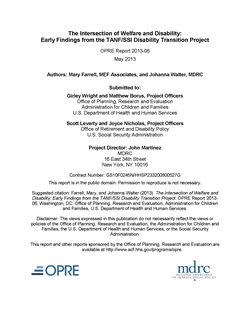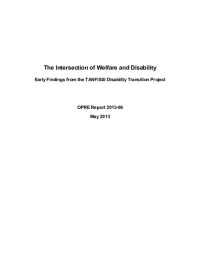The Intersection of Welfare and Disability
Early Findings from the TANF/SSI Disability Transition Project

Policymakers and program operators have long worked to understand how state and federal programs can best serve low-income families in which one parent or more has a disability. The Temporary Assistance for Needy Families (TANF) program, administered by the Administration for Children and Families (ACF), serves low-income families, some of whom include individuals who have disabilities or other work limitations. The Supplemental Security Income (SSI) program, administered by the Social Security Administration (SSA), serves low-income individuals who are aged, blind, or disabled. Though these two programs have overlapping goals of supporting low-income people with disabilities, while encouraging self-sufficiency and employment, they have key differences in approach, structure, and definitions that pose challenges to coordination.
In order to understand how best to serve TANF recipients with disabilities, ACF contracted with MDRC and its partners, MEF Associates and TransCen, to conduct the TANF/SSI Disability Transition Project (TSDTP). This first report of the TSDTP describes how TANF agencies work with participants who have a disability and how they interact with local SSA offices. It is based on field assessments in California, Florida, Michigan, and Minnesota. The report also presents findings from analyses of merged TANF and SSI data, documenting the extent to which adult TANF recipients are connected with the SSI system and how they contribute to the overall dynamics of caseload changes in SSI. Data from these separate programs have not been analyzed together before now, so the report offers unique and important analytical insight.
Key Findings
- The overlap between the TANF and SSI populations is not large. In the research sample, less than 10 percent of TANF recipients had an open SSI application, and just 6 percent of adults applying for SSI received TANF benefits within a year of the application.
- Most TANF recipients who apply for SSI do so long before nearing their federal benefit time limit.
- After accounting for differences in basic eligibility characteristics between the two groups (differences driven by TANF eligibility rules), TANF recipients who applied for SSI were slightly less likely to be found disabled, especially at the initial level, than other SSI applicants.
- TANF recipients who are exempt from requirements to participate in work activities due to a disability generally have access to few targeted services designed to increase their self-sufficiency.
- There is little coordination between the TANF programs and the SSA field office or the Disability Determination Services (DDS) — the state agency that makes the initial disability determination for SSA — during TANF recipients’ SSI application period. TANF employment counselors have expressed strong interest in knowing more about the SSI application process.
The TSDTP is in its second phase. This phase is assessing three pilot programs — developed using the knowledge gained during the first phase — that take varied approaches to improving services for TANF recipients with disabilities. Subsequent project reports will present pilot findings and further data analysis.






